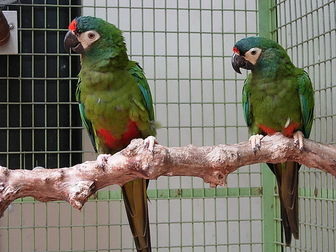Blue-winged Macaw
It has a total length of approximately 40 cm . It has a heavy black bill, a long tail and a mainly green plumage. The upperside of the remiges and primary coverts are blue, as indicated by its common name. The underside of the wings is yellowish, the tail-tip, crown and cheeks are bluish, and the tail-base and small belly-patch are red. The iris is amber. It and the Red-bellied Macaw are the only macaws where the bare facial-skin is yellowish, but this often fades to white in captivity. Unlike the Red-bellied Macaw, the Blue-winged has a red lower abdomen and a red lower back.

Original source: originally posted to Flickr as illiger's macaw
Author: TJ LinPermission(Reusing this file)This image, which was originally posted to Flickr.com, was uploaded to Commons using Flickr upload bot on 10:18, 19 February 2009 (UTC) by Snowmanradio (talk). On that date it was licensed under the license below. This file is licensed under the Creative Commons Attribution-Share Alike 2.0 Generic license.You are free:to share – to copy, distribute and transmit the work
The Blue-winged Macaw is classified as Near Threatened (NT), is close to qualifying for or is likely to qualify for a threatened category in the near future.
The Blue-winged Macaw (Primolius maracana), in aviculture more commonly known as Illiger's Macaw, is a species of macaw found in central and eastern South America. It was previously placed in the genus Ara or Propyrrhura. Blue-winged Macaws have been known to reach an age of 50–60 years. More
The Illiger's Macaw or Blue-winged Macaw makes for a good pet because of its small size and high intelligence. However they are lively boisterous birds and so will require a generous living space. This very active, inquisitive, and amusing little parrot will investigating and chew everything in sight. Young hand-raised Illiger's Macaws make wonderful pets. They are very adaptable and relatively easy to take care of. A friendly and sweet little bird that is handleable by many people. More
Blue-winged Macaw in the wild © Nick Athanas | http://www.antpita.com Blue-winged or Illiger’s Macaws foraging © Arthur Grosset | http://www.arthurgrosset. More
Did You Know?Some wild Blue-winged Macaws have problems with cataracts when they age, which shortens their life due to the handicap of not being able to locate food. Species Profile Genus: Primolius Species: maracana Size: Adult Weight: 43cm (16.8 in) 265g (9. More
Blue-winged macaw, otherwise known as ara macao, isolated on a white background Image Viewed: 4411 times COMMENT ON THIS PHOTO To have your name appear with your comment, you will need to register/log in as a Member. More
Macaw (Primolius maracana) - also known as Blue-winged Macaw - is endemic to eastern Brazil, Mato Grosso in Brazil, Paraguay and north-eastern Argentina; where it can be found in coastal forest areas up to 3300 feet. Sometimes they can be observed foraging in grain or maize fields. Their natural diet consists of seeds, fruits, nuts and berries. This macaw is endangered in its own habitat as it is destroyed by deforestation. More
Blue-winged Macaws have been known to reach an age of 50-60 years. Habitat and food - The Blue-winged Macaw occurs in eastern and southern Brazil (with a remnant population north-east), eastern Paraguay and, at least formerly, in far north-eastern Argentina. It occurs in evergreen and deciduous forests, with a preference for gallery forest. They mainly feed on seeds of Cnidoscolus phyllacanthus, Jatropha, Guazuma ulmifolia and the non-native Melia azederach. More
In Argentina, the Blue-winged Macaw was widespread in the province of Misiones, with numerous historic records at various localities. In our study area, the species was common until 1970. The Blue-winged Macaw is a large, noisy, conspicuous bird. However, the past 20 years have produced no reliable records of the species in Argentina. In five years of field work and interviews with local people at many sites throughout Misiones, we did not record this macaw. More
Blue-winged Macaw Calls in flight Primolius maracana (0:29) Ciro Albano XC39986 11-10-2009, Brazil Blue-winged Macaw calls Primolius maracana (0:13) Andrew Spencer XC47881 27-09-2009, Brazil Blue-winged Macaw calls Primolius maracana (0:51) Andrew Spencer XC47882 27-09-2009, Brazil página 1 © 2005-2010 Xeno-canto Foundation. More
The Blue-winged Macaw attain sexual maturity between 2 and 4 years after they are born. Adult females usually produce two eggs which take approximately 29 days to hatch. Young Blue-winged Macaws learn to fly about 11 weeks after they have hatched. They stay with their parents for about a year after learning to fly. Relatively little information exists on its reproduction in the wild, but the breeding season in north-eastern Brazil is apparently from December to February. More
* Blue-winged Macaw videos on the Internet Bird Collection * Photo of a captive Blue-headed Macaw * Blue-winged Macaw photo gallery VIREO * Photo-High Res; Article tropicalbirding v • d • eMacaws Genus Species (extinctions: † indicates a species confirmed to be extinct, ₴ indicates evidence only from sub-fossils) Anodorhynchus Glaucous Macaw • Hyacinth Macaw • Lear's Macaw Cyanopsitta More
attempt with pure Blue-winged Macaw eggs was tried in the 1997-1998 breeding season, but this also met with failure when the eggs were once more eaten, either by mammalian predators or by a snake. In the next breeding season the hybrid couple made two nesting attempts. The first failed, but in December 1998 the pair laid another clutch and the researchers launched a fourth effort to get the birds to rear young. More

Original source: Original uploader was Robert01 at de.wikipedia
 Author: Original uploader was Robert01 at de.wikipedia
Author: Original uploader was Robert01 at de.wikipedia  Permission: Some rights reserved
Permission: Some rights reserved
Family : Psittacidae
Genus : Primolius
Species : maracana
Authority : (Vieillot, 1816)

